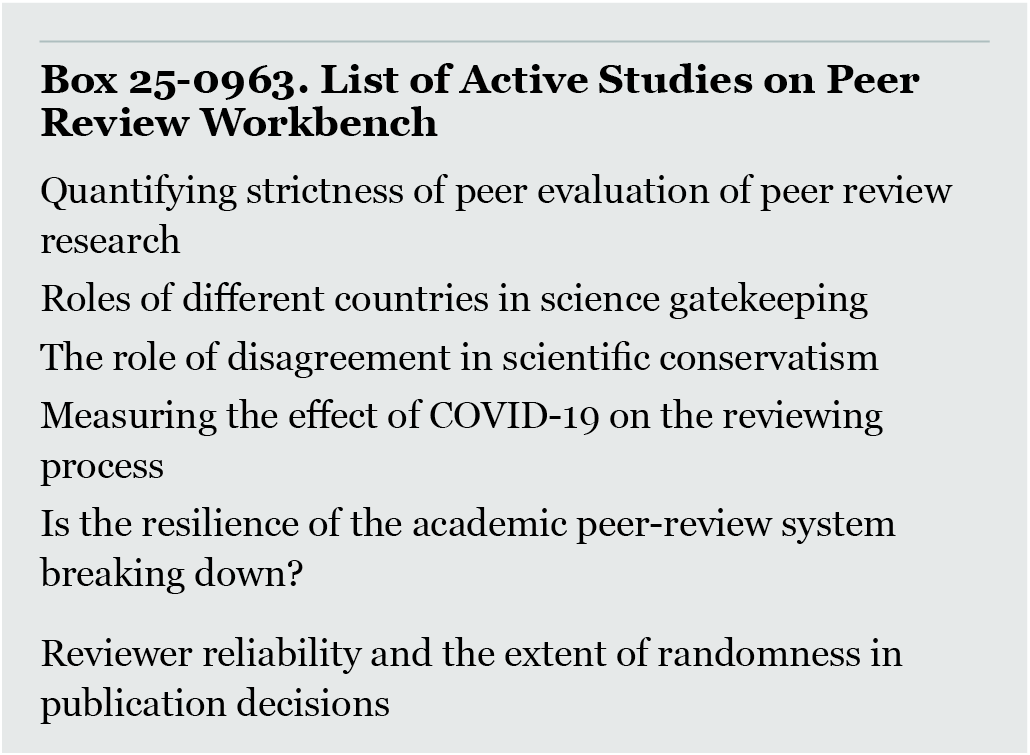Abstract
Review of Proposals Submitted to Elsevier’s Peer Review Workbench
Bahar Mehmani,1 Silvia Dobre,1 Ramadurai Petchiapppan1
Objective
To encourage evidence-based peer review studies, Elsevier launched the Peer Review Workbench (PRW) in 2022. Here we report on the studies that have since worked in PRW, as we believe peer review studies at large scale are needed for the progress of research on research and understanding how to improve the quality of the peer review process.
Design
PRW is a curated and anonymized dataset of all Elsevier journal manuscript and peer review metadata on more than 5 million authors and reviewers. In our white paper,1 we describe all the attributions and results of some calculations such as variation of interrater agreement, number of peer reviewers per manuscript, peer review rounds, gender balance, and country representation in editorial, authorship, and reviewers’ composition across different disciplines and impact factor quartiles. Interested researchers are provided with a proposal protocol2 to submit their research plan. All protocols go through rounds of peer review by the academic advisors of the PRW, who are listed in our page.2 The accepted applications receive an onboarding training by our data scientist (R.P.) who further prepares the relevant data segment suitable for their primary and secondary research purposes.
Results
Since September 2022, PRW has received 12 proposals, of which 6 have been accepted. Of the 6 accepted proposals, all have been onboarded and are actively working with the data. Thirty-one researchers from 17 universities in 9 countries are involved in these research projects. Based on the self-reported data, 39% (n = 12) of these researchers are women and 61% (n = 19) are men; the options “Other” and “Prefer not to disclose” were both at 0%. We promote transparency in science and therefore publish all accepted proposals on a dedicated Peer Review Workbench Research Paper Series page on SSRN.2 Box 25-0963 shows the list of research proposals currently working with the data. So far, these proposals published on SSRN have attracted over 170 downloads and almost 800 views.
Conclusions
The breadth of the ongoing studies encourages us to continue adding Elsevier journal and manuscript metadata annually to PRW and organize our seasonal seminars starting from autumn 2025 to report on the progress and findings of each study. This may also help improve the visibility of PRW.
References
1. Petchiappan R, James K, Plume A, et al. Analysing Elsevier Journal Metadata within peer review Workbench. SSRN. Revised June 9, 2025. Accessed July 16, 2025. https://papers.ssrn.com/sol3/papers.cfm?abstract_id=4211833
2. SSRN. PRW: Peer Review Workbench Research Paper Series. Accessed July 16, 2025. https://www.ssrn.com/index.cfm/en/peer-review-workbench/
1Elsevier, Amsterdam, the Netherlands, bahar.mehmani@elsevier.com.
Conflict of Interest Disclosures
All authors are employees of Elsevier, the owner of the Peer Review Workbench, the publisher of the journals whose metadata is hosted on PRW, and the owner of the submission system used for collecting the data. Elsevier is also the owner of the Scopus database that was used to enrich the journals’ metadata with their different impact factor quartiles and subject areas. Bahar Mehmani is a member of the Peer Review Congress Advisory Board but was not involved in the review or decision for this abstract.

